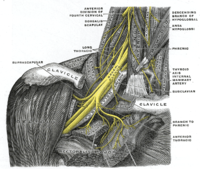
Photo from wikipedia
Purpose: To evaluate the outcomes of the Gore Excluder Iliac Branch Endoprosthesis (IBE) using division branches of the internal iliac artery (IIA) as distal landing zones. Materials and Methods: Between… Click to show full abstract
Purpose: To evaluate the outcomes of the Gore Excluder Iliac Branch Endoprosthesis (IBE) using division branches of the internal iliac artery (IIA) as distal landing zones. Materials and Methods: Between January 1, 2014, and December 31, 2018, 74 patients (mean age 74±7 years; 72 men) treated for aortoiliac or common iliac artery aneurysms had an IBE deployed with distal landing of the side branch within the main trunk (n=60) of the internal iliac artery (IIA) vs within a division branch (n=25). Thirteen (17%) patients received bilateral IBE implantations for a total of 85 vessels evaluated. Early endpoints were technical success, 30-day mortality, 30-day major adverse events (MAEs), and 30-day major access complications. Late endpoints were survival, primary and secondary IIA patency, freedom from IIA branch instability, freedom from new-onset buttock claudication, and aneurysm sac diameter changes. Time-dependent outcomes were reported as Kaplan-Meier curves with differences assessed using the log-rank test. Estimates are presented with the 95% confidence interval (CI). Results: The overall technical success rate was 97%, with 1 technical failure per group (p=0.43). Two patients, one from each group, died within 30 days (p=0.43). No significant differences were seen in the rates of 30-day MAEs (7% vs 17%, p=0.35) or major access complications (9% vs 11%, p>0.99) for patients receiving distal landing in the main trunk vs a division branch, respectively. The mean follow-up for the entire cohort was 19±12 months. The overall 1-year survival rate was 94% (95% CI 74% to 99%). The primary and secondary patency rates at 1 year were 98% (95% CI 88% to 99%) vs 95% (95% CI 72% to 99%, p=0.72) and 98% (95% CI 88% to 99%) vs 100% (p=0.41) for the main trunk vs division branch groups, respectively. Freedom from IIA branch instability estimates were also similar at 1-year follow-up [93% (95% CI 82% to 97%) vs 90% (95% CI 66% to 97%), p=0.29], as were the freedom from new-onset buttock claudication estimates [98% (95% CI 86% to 99%) and 94% (95% CI 67% to 99%), respectively; p=0.62]. Mean sac diameter change was 5.4±5.3 mm, not significantly different between the groups (p=0.85). Conclusion: Use of the posterior or anterior division of the IIA as a distal landing zone for the Gore Excluder IBE was safe and efficacious in the midterm. This technique may permit extending indications for endovascular repair of aortoiliac aneurysms to cases with unsuitable anatomy within the IIA main trunk. Long-term assessment is needed to affirm the efficacy of this technique.
Journal Title: Journal of Endovascular Therapy
Year Published: 2020
Link to full text (if available)
Share on Social Media: Sign Up to like & get
recommendations!